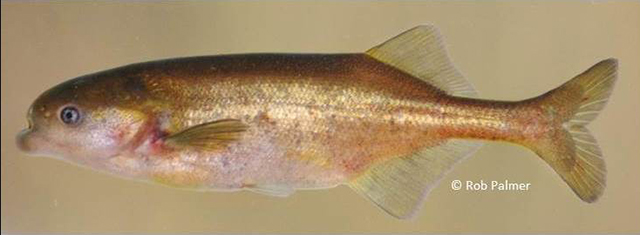|
Dorsal spines (total): 0-0; Dorsal soft rays (total): 20-23; Anal spines: 0-0; Anal soft rays: 26-28; Vertebrae: 42-43. Diagnosis: Marcusenius pongolensis can be distinguished from its congeners by the following characters: a more slender body, elongated, smaller body depth, 19.1-26.0% of standard length; distance from dorsal fin origin to end of caudal peduncle 37.1-39.8% of standard length; distance from anal fin origin to end of caudal peduncle 40.8-42.2% of standard length; and length of anal fin 19.5-21.9% of standard length; all shorter and non-overlapping with Marcusenius krameri, M. caudisquamatus and M. lucombesi (Ref. 95448). Total vertebrae ranges between 42-43 vs. 44 in other species; posterior total gill rakers 13-14 vs. 15 and 17 in M. caudisquamatus and M. krameri, respectively; lateral line scales 70-73; scales around caudal peduncle 16-17; dorsal fin rays 20-23; anal fin rays 26-28 (Ref. 95448). Electric organ discharge (EOD) lacking a weak head-negative pre-potential, in females and juveniles Ndur of short duration, no striking sexual dimorphism in EOD waveform present, but longer EOD duration and statistically significant increase with standard length in males (Ref. 75962).
Description: Head with terminal mouth well in front of eye, mental lobe on lower jaw protruding beyond upper jaw; head and body dorsolaterally compressed (Ref. 75962). Dorsal fin situated about three fourths of standard length from snout, obliquely orientated, anteriorly higher and posteriorly lower, distal margin sometimes only slightly crescentic with anterior two or three rays longer than posterior rays, number of rays 20-23; anal fin opposite dorsal fin with distinctly more anterior origin, obliquely orientated, anteriorly lower and posteriorly higher, anterior rays longer than posterior ones, especially in males where they also appear stronger and often darkened, distal margin crescentic, number of rays 26-28 (Ref. 75962, 95448). Scales cycloid with reticulate striae, scales extending anteriorly to operculum and pectoral fins; scales on caudal peduncle circumference, 16-17 (Ref. 75962, 95448). Caudal peduncle subcylindrical entire length, 18-22% of standard length (Ref. 75962). Electric organ discharge biphasic lacking a weak pre-potential, in females and juveniles Ndur of short duration; in large males, statistically longer EOD duration and significant tendency for increase of both Pdur and Ndur with standard length, however, no sexual dimorphism when compared to upper Zambezi males (Ref. 75962).
Colouration: Colour in life ranging from an almost homogeneous medium brown to grey-brown with yellow-golden shimmer, sometimes going into purple, underside lighter, a few strongly faded, darker blotches on sides detectable, fins yellowish (Ref. 75962, 95448). Colour in preservation light to medium brown, fins whitish; irregular fair spots on body sides (Ref. 75962). |

